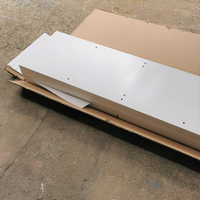The Bunnings Workshop community can help with your home improvement projects.
- Bunnings Workshop
- >
- How To
- >
- How to build a cube storage cabinet
How to build a cube storage cabinet
- Subscribe to RSS Feed
- Mark as New
- Mark as Read
- Bookmark
- Subscribe
- Printer Friendly Page
- Report Inappropriate Content
Difficulty: Intermediate
Cube storage cabinets are a great way to keep your home organised and tidy.
This guide will show you how to build a cabinet by adding a timber top and legs to a cube storage unit. You can customise this project to suit any type and size of unit.
As this project involves power tools, please follow all safety guidelines provided by manufacturers and use the recommended protective gear, including safety glasses and a face mask.
Steps
Step 1
Assemble the cube storage unit.
Unbox your cube storage unit and place it on a flat surface.
Start assembling the pieces as per the instructions. Ensure you tighten all fixings securely.


Step 2
Attach leg plates and legs to the cube storage unit.
Position the leg plates in all four corners of the unit. Mark their locations through the central hole.
Now measure approximately 20mm away from the tip of your 8mm drill bit. Apply masking tape at that point. This tape will prevent you from drilling completely through the unit's base.
Remove the leg plates and drill 20mm deep holes in the marked points with your drill driver.
Return the leg plates to position, ensuring their central holes are aligned with your drilled holes. Attach the leg plates to the unit using three 20mm button screws per plate. Screw the legs onto the unit.





Step 3
Measure and cut the timber panel.
Place your timber panel on top of the unit. Allow a small overhang on one end and measure the distance from the panel to the edge of the unit. Now measure and mark the opposite end of the panel the same distance away from the other edge of the unit. I marked a point 270mm away from the edge of my panel, allowing for a small and equal overhang on each side of the unit.
Mark a straight line across the panel at your marked point. Clamp a straight piece of timber offset near the line. This will help keep your circular saw in position while cutting. Cut the panel to length.
Remove any rough or sharp edges from the cut panel with a sanding pad.







Step 4
Attach the cut panel to the cube storage unit.
Place the cut timber panel on the unit. Position it so there's an even overhang on each side.
Measure 45mm away from the tip of your 3mm drill bit. Apply masking tape at that point. This tape will prevent you from drilling completely through the timber panel.
Drill four holes through the top of the unit into the panel.
Now take four 45mm screws and place four countersunk washers on them. Use these screws to attach the timber panel to the unit.
You should now have a cube storage cabinet with a top and legs.



Step 5
Attach the cube storage cabinet to your wall to prevent it from toppling forward.
Position the cabinet in your desired location. Locate two wall studs with your stud finder. Here are tips on how to use a stud finder.
Now attach two angle brackets to the underside of the top of the cabinet using 20mm screws. Attach the brackets to the wall studs using 45mm screws.
If you have a masonry wall, you can install plastic wall plugs for attachment.
Place your cube inserts in the cabinet and style it accordingly.
You have successfully built a cube storage cabinet.



Materials
- Storage cube unit, like Flexi Storage Clever Cube 76 x 39 x 146cm White 2 x 4 Storage Unit
- Four cube inserts, like Flexi Storage Clever Cube Natural Water Hyacinth Insert
- Timber panel, like SpecRite 1800 x 405mm 18mm Timber Panel Beech FJ Laminated
- Four round furniture legs, like Adoored 125mm Pine Round Furniture Leg
- Four leg plates
- 15 x 20mm button screws
- 8G x 45mm chipboard screws
- Countersunk washers
- Two 30mm angle brackets.
Tools
- Drill driver
- Circular saw
- 3mm long drill bit
- 8mm drill bit
- Marker
- Masking tape
- Clamps
- Sanding pad
- Stud finder
- Safety gear, like safety glasses and face mask.
Images
























You must be a registered Workshop community member to comment. Please join Workshop or sign in to join in the discussion.
Why join the Bunnings Workshop community?
Workshop is a friendly place to learn, get ideas and find inspiration for your home improvement projects
You might also like
We would love to help with your project.
Join the Bunnings Workshop community today to ask questions and get advice.










